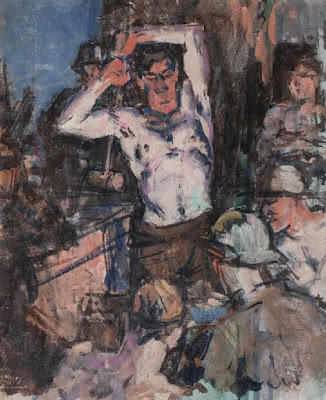Nueva York, 1896. John Schuyler Moore, reportero del New York Times, recibe de madrugada la llamada de su antiguo compañero de estudios, el alienista (psicólogo) Laszlo Kreizler, para participar en la cacería de un temible asesino. Se ha descubierto el cadáver horriblemente mutilado de un chico, un chico con ropas de niña. Este joven era, evidentemente, un prostituto del Paresis Hall, famoso punto de encuentro para los que entonces eran descritos como "degenerados sexuales". Paresis Hall, estaba el Bowery en la 5th Street, cerca de Cooper Union. Inaugurado por James T. ('Biff') Ellison. Ellison (un mafioso afiliado a los Gang de "Five Points" -Revisar Gangs of New York- y después a la Gopher Gang) y no intentó disimular que su establecimiento era uno "fairy resort".
Chicos de Paresis Hall, N.Y. (1893)
Los prostitutos actuaban del mismo modo que las mujeres: recorriendo las mesas seduciendo a los hombres para así obtener una comisión sobre las bebidas vendidas. Actuaban de manera "afeminada", maquillándose como mujeres y gritándose con nombres femeninos ...
James T. ('Biff') Ellison c.1900
Según declaraciones de Joel S. Harris, investigador policial a la época del Paresis (back2stonewall)
“I was with Mr. (John R. Wood, another investigator) last night at Paresis Hall, No 392 Bowery. I observed the actions of the persons congregated there. I saw and heard immoral actions and propositions by degenerates there. Captain Chapman came in about five minute to 1, as we stepped out. … We had been in the place about an hour or so; plenty of time for information to get from Paresis Hall to the stationhouse. Captain Chapman didn’t say anything to us, but I overheard him say to the proprietor … that he would not tand for any dancing on souvenir night, and he wanted it shut up. I have been in that place before, recently, three or four times, and I have on each occasion noticed the same conduct as I have just testified to. That is a well-known resort for male prostitutes; a place having a reputation far and wide, to the best of my knowledge. I have heard of it constantly. I have never had any trouble in going in. You go in off the street with perfect ease. These men that conduct themselves there — well, they act effeminately; most of them are painted and powdered; they are called Princess this and Lady So and So and the Duchess of Marlboro, and get up and sing as women, and dance; ape the female character; call each other sisters and take people out for immoral purposes. I have had these propositions made to me, and made repeatedly. There is not difficulty in getting into that place.“
George P. Hammond, Jr., también testificó:
I know this place called Paresis Hall, and under your directions I have visited it a number fo times. I have been in the place since April 1st to the present time fully half a dozen times. I knew of it before, as an officer of the City Vigilance League. I am in the produce business. When this committee began its sessions I took a vacation on the produce business and came in to help you. The character of the place is such that what we call male degenerates frequent the place, and it is a nightly occurrence that they solicit men for immoral purposes. They have one woman who goes there they call a hermaphrodite. These male degenerates solicit men at the tables, and I believe they get a commission on all drinks that are purchased there; they get checks. I have observed five or six of these degenerates frequent that place, possibly more; the last we were there we saw a greater number than we did previously. Those five or six are always to be found there; almost invariably you will find them there .hey go from there across the street to a place called Little Bucks, opposite, and from there to Coney Island. I have never had any difficulty in getting in; not the least; I have been received with open arms. There are two ways of going in, one way up through the barroom, the other through a side entrance; any way at all that suits you can walk in … They have a piano there, and these fairies or male degenerates, as you call them, they sing some songs.
Chicos del Paresis Hall, N.Y.
Las siguientes fotos son de algunos de los jóvenes que trabajaban en el Paresis Hall (también conocido como Columbia Hall), uno de los seis burdeles de hombres que había en el Nueva York de finales del siglo XIX. Las fotografías son del 1890 al 1899 y, o bien se vendieron o regalaron a los clientes.
Amos Jones
Arnold Doyle
Billy Walsh
Charley Ford
Danny Moore
Francis 'The Horse' Kane
George Horn
Jimmy Smith
Johny Gibson
Joshua
Nathaniel 'The Kid' Cullen
Raymond
Tim Kelly
Tommy O'Rourke
Willy 'the Bull' Pearson
Paresis Hall no solo era un prostíbulo, era un lugar donde muchos hombres y jóvenes de la clase obrera de los barrios bajos se encontraban y donde podrían celebrar reuniones no supervisadas, crear clubes sociales informales e incluso patrocinar bailes. Unos pocos hombres del Paresis Hall organizaron un club llamado Círculo Hermafroditis, que alquilaba permanentemente una habitación por encima del bar. En aquella época, las leyes contra el transvestismo eran implacables, así como la actitud social, ir vestido de mujer por las calles era muy peligroso. Paresis Hall les dio un espacio donde podían reunirse sin miedo, y almacenar algunas de sus cosas personales en un lugar más privado.
Nuevamente una novela, ahora convertida en serie de televisión, saca a la luz parte de la historia de Nueva York, historia sin épica, sin gloria, pero muy importante, es la historia de la gente que ha forjado la ciudad, una ciudad con unos orígenes violentos y oscuros, y plenos de atractivos.
+Información:
http://www.back2stonewall.com/2018/01/paresis-hall.html
http://www.boxturtlebulletin.com/2012/06/01/45020
http://gvshp.org/blog/2014/12/04/lgbtq-history-cooper-square-and-bowery/












































